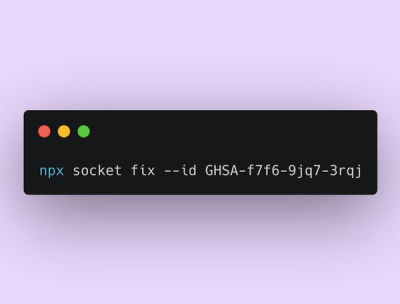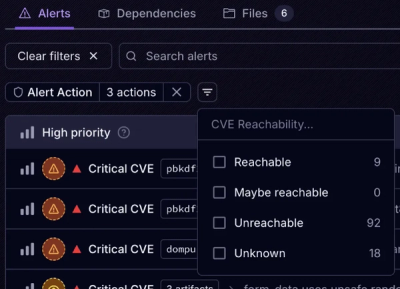
Product
Announcing Socket Fix 2.0
Socket Fix 2.0 brings targeted CVE remediation, smarter upgrade planning, and broader ecosystem support to help developers get to zero alerts.
A Django app providing customizable color selection fields for your models with Bootstrap color integration. Can be used with or without Bootstrap and can be easily extended to support any CSS framework or custom color palette.
Django Colors offers a simple yet powerful way to add color selection capabilities to your Django models. It provides:
The app is designed to be flexible, allowing you to use either the built-in Bootstrap color options or define your own custom colors through Django models.
pip install django-colors
Add 'django_colors' to your INSTALLED_APPS setting:
INSTALLED_APPS = [
...
'django_colors',
...
]
Add a color field to your model:
from django.db import models
from django_colors.fields import ColorModelField
class MyModel(models.Model):
name = models.CharField(max_length=100)
color = ColorModelField()
By default, this will use Bootstrap color choices for background colors.
To use text colors instead of background colors:
from django_colors.field_type import FieldType
class MyModel(models.Model):
name = models.CharField(max_length=100)
color = ColorModelField(color_type=FieldType.TEXT)
Create a model for custom colors:
from django_colors.models import ColorModel
class MyCustomColor(ColorModel):
"""Custom color definitions for my app."""
class Meta:
verbose_name = "Custom Color"
verbose_name_plural = "Custom Colors"
Use your custom colors in a field:
class MyModel(models.Model):
name = models.CharField(max_length=100)
color = ColorModelField(model=MyCustomColor)
You can configure the app globally in your settings.py:
COLORS_APP_CONFIG = {
'default': {
'default_color_choices': 'django_colors.color_definitions.BootstrapColorChoices',
'color_type': 'BACKGROUND',
},
'my_app': {
'default_color_choices': 'myapp.MyCustomColorChoices',
'color_type': 'TEXT',
},
'my_app.MyModel.color_field': {
'model': 'my_app.MyCustomColor',
'only_use_custom_colors': True,
},
}
# You can also import your custom color choices directly
from django_colors.color_definitions import BootstrapColorChoices
COLORS_APP_CONFIG = {
'default': {
'default_color_choices': BootstrapColorChoices,
'color_type': 'BACKGROUND',
},
'my_app': {
'default_color_choices': 'myapp.MyCustomColorChoices',
'color_type': 'TEXT',
},
'my_app.MyModel.color_field': {
'model': 'my_app.MyCustomColor',
'only_use_custom_colors': True,
},
}
only_use_custom_colors, you must set a model, as it will
not use the default color choices.The app includes templates for rendering color selections:
color_select.html - Main template for the color selection widgetcolor_select_option.html - Template for individual color optionsYou can override these templates in your project by creating your own versions in your templates directory.
A dataclass representing a single color option with the following attributes:
value: Unique identifier for the colorlabel: Human-readable labelbackground_css: CSS class for background colortext_css: CSS class for text colorBase class for defining a collection of color options with methods to:
Pre-defined color choices based on Bootstrap's color system, including:
Enum defining the type of color field:
BACKGROUND: For background color CSS classesTEXT: For text color CSS classesA custom Django field for selecting colors, with options for:
"myapp.MyModel")model: Model class or string reference for custom colorsmodel_filters: Dictionary of filters to apply to the custom model querysetcolor_type: FieldType.BACKGROUND or FieldType.TEXTdefault_color_choices: Class to use for default color choicesonly_use_custom_colors: If True, only show custom colors (no defaults)ordering: Tuple of field names for ordering custom model choiceslayout: Layout for combining default and custom choices ("defaults_first", "custom_first", "mixed")The get_choices() method provides flexible options for retrieving color choices:
field.get_choices(
additional_filters=None, # Extra filters for model queryset
model_priority=False, # Ignore filters and return all model options
include_blank=False, # Include blank option
blank_choice="---------", # Custom blank choice text
ordering=None, # Override field ordering
layout=None, # Override field layout
sort_by=None, # Sort by "value" or "label"
)
Abstract base model for custom color definitions with fields for:
name: Color namebackground_css: CSS class for background colortext_css: CSS class for text colorCustom form widget for color selection.
The ColorModelField class will render as a Select field in forms.
# models.py
from django.db import models
from django_colors.models import ColorModel
from django_colors.fields import ColorModelField
class TestAppColor(ColorModel):
active = models.BooleanField(default=True)
def __str__(self) -> str:
return f"{self.name}"
class TestThing(models.Model):
identity = models.CharField(max_length=100)
background_color = ColorModelField(
model=TestAppColor,
# Show only active colors along with default colors
model_filters={"active": True},
only_use_custom_colors=False,
ordering=("name",), # Order custom colors by name
layout="defaults_first", # Default colors first, then custom
null=True,
blank=True,
)
# Show only default colors
text_color = ColorModelField()
# forms.py
from django import forms
class TestThingForm(forms.ModelForm):
class Meta:
model = TestThing
fields = ["background_color", "text_color"]
# models.py
from django.db import models
from django_colors.models import ColorModel
from django_colors.fields import ColorModelField
from django_colors.widgets import ColorChoiceWidget
class TestAppColor(ColorModel):
active = models.BooleanField(default=True)
def __str__(self) -> str:
return f"{self.name}"
class TestThing(models.Model):
identity = models.CharField(max_length=100)
background_color = ColorModelField(
model=TestAppColor,
model_filters={"active": True},
only_use_custom_colors=False,
null=True,
blank=True,
)
text_color = ColorModelField()
# forms.py
from django import forms
class StandardForm(forms.Form):
color = forms.ChoiceField(
required=False,
choices=TestThing._meta.get_field("background_color").get_choices(),
widget=ColorChoiceWidget(
attrs={"class": "form-control", "hx-target": "#something"}
),
)
This showcases how to use the get_choices method to override the presets in the form:
# models.py
from django.db import models
from django_colors.models import ColorModel
from django_colors.fields import ColorModelField
from django_colors.widgets import ColorChoiceWidget
from functools import partial
class TestAppColor(ColorModel):
active = models.BooleanField(default=True)
def __str__(self) -> str:
return f"{self.name}"
class TestThing(models.Model):
identity = models.CharField(max_length=100)
background_color = ColorModelField(
model=TestAppColor,
model_filters={"active": True},
only_use_custom_colors=False,
null=True,
blank=True,
)
text_color = ColorModelField()
# forms.py
from django import forms
from functools import partial
class AdvancedForm(forms.Form):
# Show ALL options including inactive colors
all_colors = forms.ChoiceField(
required=False,
choices=partial(
TestThing._meta.get_field("background_color").get_choices,
model_priority=True, # Ignore model_filters
),
widget=ColorChoiceWidget(
attrs={"class": "form-control", "hx-target": "#something"}
),
)
# Custom layout with sorting
sorted_colors = forms.ChoiceField(
required=False,
choices=partial(
TestThing._meta.get_field("background_color").get_choices,
layout="custom_first",
sort_by="label",
include_blank=True,
blank_choice="Choose a color...",
),
widget=ColorChoiceWidget(),
)
# Only custom colors, sorted by value
custom_only = forms.ChoiceField(
required=False,
choices=partial(
TestThing._meta.get_field("background_color").get_choices,
additional_filters={"active": True},
layout="mixed",
sort_by="value",
),
widget=ColorChoiceWidget(),
)
You can reference models using strings, which is useful for avoiding circular imports:
class MyModel(models.Model):
# Reference another app's model
color = ColorModelField(
model="otherapp.ColorModel",
model_filters={"active": True},
)
# Reference a model in the same app
theme_color = ColorModelField(
model="myapp.ThemeColor",
only_use_custom_colors=True,
)
Contributions are welcome! Please feel free to submit a Pull Request.
pip install -e ".[dev]"pre-commit installpytestruff check .ruff format .When submitting a PR, ensure all pre-commit hooks pass successfully. The CI pipeline will automatically check these for you, but it's best to verify locally first.
This project is licensed under the MIT License - see the LICENSE file for details.
FAQs
An application to assist with css framework color selections.
We found that django-colors demonstrated a healthy version release cadence and project activity because the last version was released less than a year ago. It has 1 open source maintainer collaborating on the project.
Did you know?

Socket for GitHub automatically highlights issues in each pull request and monitors the health of all your open source dependencies. Discover the contents of your packages and block harmful activity before you install or update your dependencies.

Product
Socket Fix 2.0 brings targeted CVE remediation, smarter upgrade planning, and broader ecosystem support to help developers get to zero alerts.

Security News
Socket CEO Feross Aboukhadijeh joins Risky Business Weekly to unpack recent npm phishing attacks, their limited impact, and the risks if attackers get smarter.

Product
Socket’s new Tier 1 Reachability filters out up to 80% of irrelevant CVEs, so security teams can focus on the vulnerabilities that matter.